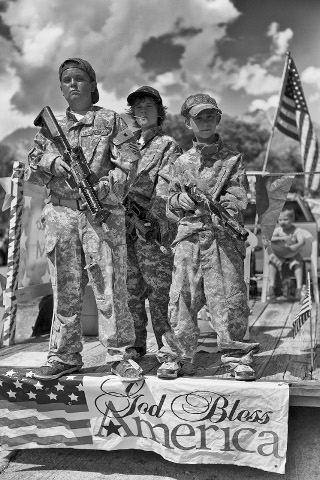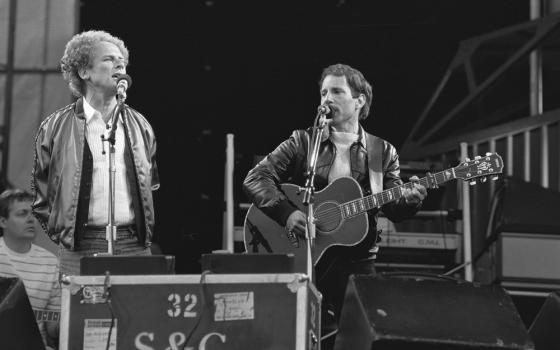
"Fourth of July parade, 2011, Independence, Calif.," by photographer Craig Semetko, from his project "America -- E Pluribus Unum" (©Craig Semetko, 2012)
I’ve been thinking a lot lately about the way images, entertainment, the news and language are socializing us into accepting a perpetual state of violence, with the mass shooting at the premiere of “The Dark Knight Rises” in the Aurora, Colo., theater on July 20 in mind.
Comic-books-into-movies is one of the most successful genres of recent times but it polarizes conflict into simplistic notions of good versus evil. Add in recent television series such as CBS’s “The Unit,” which taught military women how to behave as army wives. Now “Stars Earn Stripes” on NBC employs retired Gen. Wesley Clark to host the reality show. He told The New Republic that youth could now “see the military through the eyes of [singer] Nick Lachey, and think, look at what these people are doing. Pretty interesting, pretty tough, pretty awesome.” In the series premiere he tells us we will learn what it is like to be a soldier while Lachey says, “Nothing prepares you for battle like a boy band.”
Really?
To turn war, justified or not, into a manufactured competitive game trivializes honor. On the other hand, to a couple of generations raised on military video games, a television series such as “Stars Earn Stripes” might prove another arm of a most effective recruitment tool: entertainment.
War is a playground, a really cool playground! I didn’t say it. In airing this danger-free artificiality as entertainment, NBC did.
The words Robert F. Kennedy Jr. spoke at a screening of the 2011 documentary “The Last Mountain” continue to indict the American audience as “the best entertained and least informed people on the face of the Earth.”
A close relative was expecting a baby last year. Her husband was in the military overseas. In her excitement, and in solidarity with her husband, she posted on Facebook a picture of the camouflage outfit she purchased for the newborn. How is dressing babies and children in camouflage a good thing?
I was talking to a Catholic actor here in Los Angeles recently about this phenomenon. He sent me a photo taken this year of a “float” in a July 4 parade; the photographer gave his permission to print it here. What story does this picture tell? What Gospel values are reflected here? What does it mean? Does it make a difference? Are my feelings of horror justified? What were their parents thinking?
Film critic Todd McCarthy wrote the day after the Aurora shooting in The Hollywood Reporter that even though modern films can serve as a trip wire to some, “a lone maniac with delusions of homicidal grandeur can’t be allowed to hold our most basic desires for creative, social and escapist gratification hostage.”
Also in The Hollywood Reporter, filmmaker Peter Bogdanovich reflects on the proliferation of violence and death in movies and his regrets at making the 1968 film “Targets,” about a shooting spree that ends at a drive-in theater. He concludes: “I’m not sure what the solution is. I just know that the violence in this country is out of control. And the fact that guns are so easy to get is chilling. But nobody wants to blame the movies. Nobody wants to blame guns. And yet, it’s so easy to buy them and there are more murders in this country than anywhere else.”
Joe Klein analyzes “How the gun won” in TIME (Aug. 6). He notes that President Barack Obama’s speech in January 2011 in response to the shooting of Arizona Congresswoman Gabrielle Giffords and 18 other people was “probably the best [speech] of his presidency.” It called for “a national conversation” about “everything from the merits of gun safety laws to the adequacy of our mental health system.”
“And then ... nothing,” Klein concludes.
First Things blogger William Doino Jr. posted “Modern Films and the Enamel of Our Souls” and laments the loss in the 1960s of the Hollywood Motion Picture Production Code that gave us films that reflected Judeo-Christian values. Back then, “Whatever sins were going on in the real world, moviemakers had enough sense not to glorify or graphically depict them on screen; action and character development took place within a moral framework, where right and wrong were recognized.”
Doino is not so different from many people in the faith community who seem to think that the lack of explicit content depicting sex and violence will make everything good again, like the Golden Age of Hollywood. I don’t believe we can judge movies to be good based on what they do not contain; it depends on the story.
But what then are we to do? What are the responsibilities of filmmakers and viewers?
Twenty years ago, Cardinal Roger Mahony, then the archbishop of Los Angeles, published “Film Makers, Film Viewers: Their Challenges and Opportunities.” This guide is still relevant because it offers principles rooted in Catholic teaching and asks many good questions. But we are still at the starting point in the entertainment industry and forming audiences: What is our collective responsibility as concerned citizens and disciples, filmmakers and audience? Is anyone paying attention to the whole picture? As for violence, Mahony asks audiences to discern if violence is the only way shown to resolve problems in the film and to evaluate it accordingly.
To well-adjusted people, popcorn movies may be interesting forays into moral imagination or simply fun on a summer day. But what is the cumulative influence of these films on young people, especially if they are not growing up in a stable, nurturing home environment? People don’t do anything unless it makes sense to them on some level. If guns are OK in movies, OK in video games, OK in war, then they must be OK to solve my problem. To secure ratings that will assure the largest audiences, filmmakers remove 99 percent of blood, or all of it, thus reducing the depiction of the consequences of violence; the movies are thus sanitized and can appear to be a game.
A look at the number of deaths from handguns in the United States in 2011 -- 11,493 -- and total U.S. military personnel deaths in the war with Iraq -- 4,488 between March 2003 and February 2012 -- and it is easy to see that there is something terribly wrong with this picture.
The remarks that victims and Obama made in the days after the shootings in Aurora, just miles from where the Columbine High School shootings took place in 1999, reflect the process of anesthetization-by-misdirection that happens when we are faced with unspeakable violence outside the rules of what we find acceptable.
People told the news media that life is short and each day should matter. On Facebook people were outraged that young parents had taken infants to the theater at night as if bad parenting was the problem. “What matters at the end of the day is not the small things,” the president opined. “It’s not the trivial things, which so often consume us and our daily lives. Ultimately it’s how we choose to treat one another and how we love one another. ... At the end of the day, what we’ll remember will be those we loved and what we did for others.”
Really?
While the president does address vulnerable populations, he stays away from any discussion of what influence the entertainment media, a culture of war, and a culture of death and guns might have on susceptible people.
[Sr. Rose Pacatte, a member of the Daughters of St. Paul, is the director of the Pauline Center for Media Studies in Los Angeles.]




